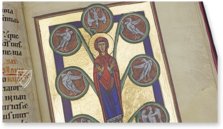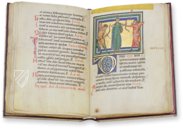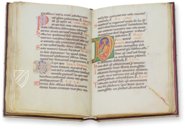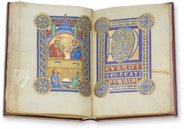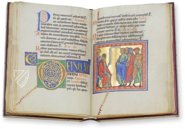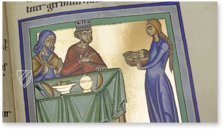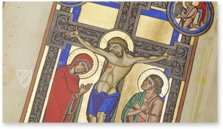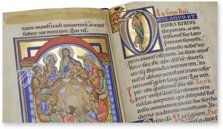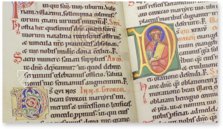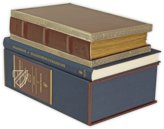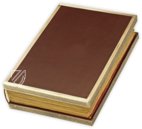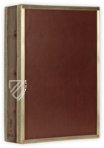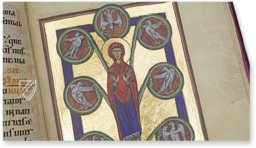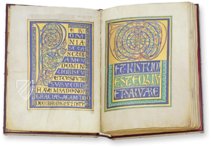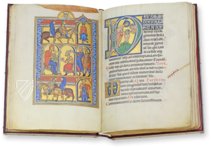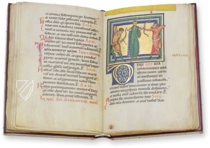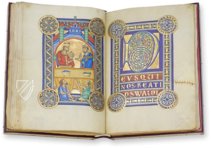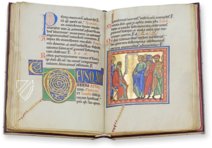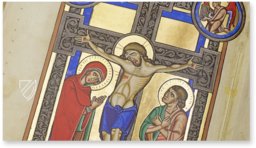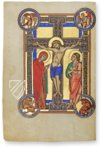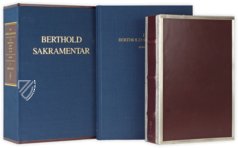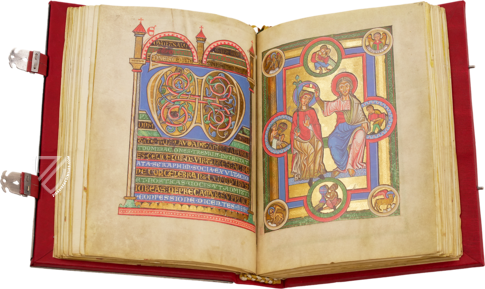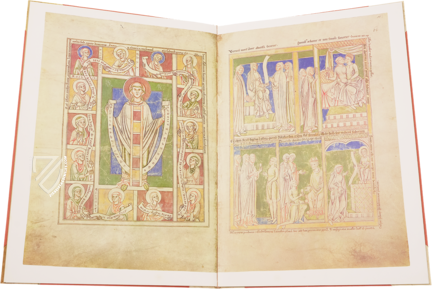Berthold Sacramentary
(3,000€ - 7,000€)
At the beginning of the 13th century, the ambitious and art-loving Abbot Berthold (r. 1200–1232) turned the Benedictine monastery of Weingarten into one of the most important centers of book illumination. He was only able to achieve this because one of his monks was blessed with an incredible talent for illumination: the anonymous Berthold Master. The imaginative initials and emotional miniatures are subtle in expression and at the same time magnificently adorned with lavish gold. The illumination shows both Anglo-Saxon and Flemish influence, which is a unique feature of the Weingarten scriptorium at the transition from late Romanesque to early Gothic. It is impossible to study the 128 miniatures, historiated and ornamental initials and calendar pages arranged on 165 parchment leaves without marvelling at their uniqueness.
Berthold Sacramentary
In 1200, Berthold von Hainburg was elected abbot of Weingarten, a man who was to have a lasting influence on the fortunes of the convent and lead the monastery to the glorious climax of its history. Berthold's greatest achievement was the unrestricted promotion of the artistic activities of his scriptorium, which developed an unprecedented level of productivity after the devastating fire of 1215, in which a large part of the abbey was burned to the ground. During this time, the abbot not only ensured the rapid reconstruction of the monastery, he also commissioned numerous manuscripts of the highest artistic quality. The most magnificent codex among them was the Berthold Sacramentary.
The Scriptorium of Weingarten Abbey
The Benedictine abbey of Weingarten, founded in 1053 on the Martinsberg above Ravensburg, already had an independent, efficient scriptorium around 1100.
The special and unique characteristic of the 12th century Weingarten book illumination lies in the frequent use of Anglo-Saxon and Flemish stylistic elements. This is not surprising, as Judith of Flanders, the wife of Duke Welf IV and sister-in-law of the English king, had donated several codices to her monastery in 1094. The Weingarten scriptorium based its own production on these manuscripts and reached a remarkable artistic level within a few decades.
However, Weingarten's book illumination experienced its heyday in the first decades of the 13th century - and it owes this to a fortunate coincidence: Abbot Berthold, the ambitious, art-loving head of the monastery, and the so-called Berthold Master, an outstanding miniaturist, were two personalities who came together, each of whom needed the other to realize his plans: The abbot demanded exceptional artistic achievements in order to enhance the monastery's reputation, while the illuminator needed the material conditions and extensive freedom to develop his incomparable talent.
This congenial interplay resulted in illuminations that are among the most beautiful of their genre.
The Master of the Berthold Sacramentary
Although only four manuscripts (with a total of 92 miniatures) can be attributed to him with certainty, the Berthold Master is regarded as one of the most independent and important artistic personalities of medieval book illumination.
The miniatures by this anonymous illuminator, who is known as the “Berthold Master” after his patron, are characterized by the vivid dramatic design of the scenic action, a new plasticity achieved through the modelling application of colour and an infinite degree of creativity. In addition, there is an unusually independent approach to outdated traditions. The influences of Anglo-Saxon and Flemish book illumination, which can be explained by the special historical situation of the monastery and its connection with the Guelphs, merely serve as sources of inspiration for the Berthold Master, from which he develops his own very personal style - with an extraordinary mastery of technical and formal means.
In the fusion of content and decorative ornament into a unified whole and in the artist's highly developed sense of style and form, which can be seen on every page of his main work, the Berthold Sacramentary, the Romanesque artistic intention finds its purest expression.
The Journey of the Manuscript to the Pierpont Morgan Library
The Berthold Sacramentary is undisputedly the main work of the Weingarten school and was guarded like a treasure in the abbey for centuries as a “thesaurus”, a precious possession.
It was not until the secularization in 1803 that it had to leave its place of origin. Together with other valuable pieces from the library and the treasury, the manuscript was first sent to Fulda and finally (after the occupation of Fulda by French troops in October 1806) to Paris. There the codex was sold in 1818 by an art dealer to Thomas Coke, Earl of Leicester at Holkham Hall, from whom it passed into the possession of the American banker John Pierpont Morgan Jr. in 1927.
The Berthold Sacramentary has found its (probably final) home in the Pierpont Morgan Library in New York, where it is one of the most valuable cimelia.
A Manuscript of World Class
There are very few codices in the world that stand out as solitaires from the relatively large medieval production of high-quality manuscripts - the Berthold Sacramentary is one of these few.
The magnificent manuscript, which was probably commissioned by Abbot Berthold immediately after the great fire of 1215, in which, among other things, the monastery library was severely damaged, stands far above most comparable liturgical books of the late Romanesque period in terms of form and material.
Sensational Illumination
21 full-page and 7 smaller miniatures, 6 full-page, 12 half-page and 52 smaller ornamental initials, 18 figurative initials and 12 calendar pages make up the book illumination of the 165 parchment leaves. In addition to the quantity of images, they are of exceptional quality. In them, the unknown miniaturist, who has gone down in art history with the notable name ”Berthold Master”, proves himself to be an artist of the first rank. His importance can be seen in almost all areas of artistic expression: By emphasizing the organic structure and combining the individual parts into a unified whole, he overcame the rigid structure of traditional depictions of human figures; his expressive, modelling brushstrokes and the frequent use of highlights lend the bodies additional sculptural value; the dynamic movements serve to dramatically enliven the scenes and create spatial relationships; the well-considered use of colour enhances the decorative effect.
One of the Berthold Master's greatest achievements, however, lies in the free interpretation of the themes given to him, the independence of his iconographic solutions. Like all artists of this period, he also drew on the rich tradition of biblical topics, especially in Byzantine and - particularly exemplary for Weingarten book illumination - Anglo-Saxon and Flemish manuscripts. Like no other, however, he frees himself from superficial quotations by combining content and form into an inseparable unity. In this, and in the perfection of the painterly realization, the Berthold master has an inestimable merit.
Costly Noble Metals for a Noble Manuscript
In addition to the high artistic status of the Berthold Sacramentary, the lavish use of noble metals adds considerable material value. All the miniatures and most of the initials are backed with gold and silver, which lends the colors a special radiance.
However, anyone who believes that this generous use of metallic colors is already the pinnacle of luxurious decoration will be surprised by a further increase in the Berthold Sacramentary: the gold backgrounds of a total of 32 miniatures and initials are highly polished; in six pictures, the golden backgrounds were additionally decorated with significant reliefs in a technically complex process. The Berthold Master reserved this highest level of decorative splendor - in artistic prudence and self-restraint - for the depictions of the main festivals of the church year and the monastery.
As the greatest treasure of Weingarten Abbey, the Berthold Sacramentary was finally given a sumptuous binding adorned with gilded silver reliefs and filigree decoration and studded with gemstones, whose rich iconographic program establishes a direct link to the monastery and the patron, Abbot Berthold. This binding - and this is another rarity in the history of books - has been preserved in its original state to this day.
Despite all the enthusiasm for the artistic design of the codex, the key role of its content, the liturgical text, should not be overlooked. With the Canon of the Mass, the Temporal, the Sanctoral and numerous votive masses, the manuscript contains the canonical selection of texts for sacramentaries. The calligraphic perfection of the manuscript, written by a total of three scribes, matches the quality of the illumination, which together make up a unique work of art in the history of book illumination.
Codicology
- Alternative Titles
- Berthold-Sakramentar
- Size / Format
- 330 pages / 29.3 × 20.4 cm
- Origin
- Germany
- Date
- Between 1200 and 1232
- Epochs
- Style
- Language
- Script
- Gothic minuscule
- Illustrations
- 128 ornamental pages with 21 full-page, 5 half-page, and 2 small miniatures; 6 full-page illuminated texts; 19 historiated initials; numerous decorated initials; many with gold- and silver-leaf, some highly burnished.
- Content
- Sacramentary
- Patron
- Berthold von Hainburg, Abbot of Weingarten Abbey (1200–1235)
- Artist / School
- Berthold master (illuminator)
- Previous Owners
- Weingarten Abbey
St. Peter's Abbey, Salzburg
Frederick Wilhelm of Orange Nassau
General Niboyet
Monsieur Delahante
H. Philipps
Thomas William Coke, Earl of Leicester
Pierpont Morgan Jr.
Berthold Sacramentary
Adoration of the Magi
Instead of a stable, the artists made use of rounded arches to create a palatial scene in the central register of this miniature with a glimmering gold background. Mary is enthroned like a queen receiving the homage of her vassals to their newborn liege lord. The Three Kings approach with their gifts, the first two presenting theirs while the third waits patiently. The baby Jesus extends his right hand toward them giving the sign of benediction.
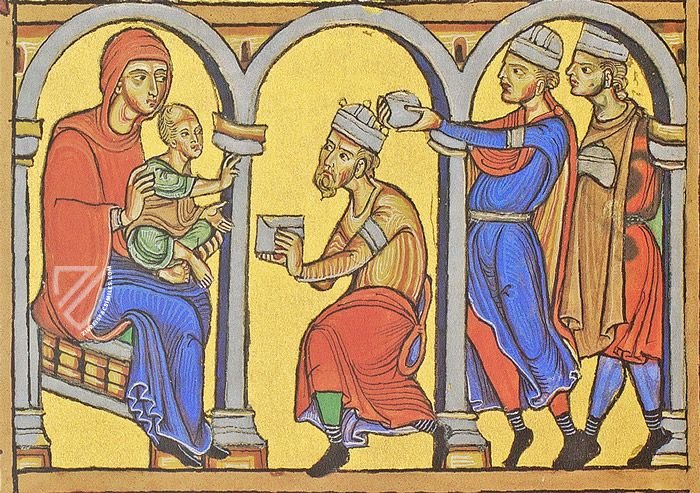
Berthold Sacramentary
The Death of the Virgin
The illumination of this incomparable work of late Romanesque art is distinguished by the refinement of its miniatures, which are richly adorned with gold and silver. The Berthold Master’s depiction of this popular subject is distinguished by its masterful execution and tremendous emotionality.
The expressions of the Twelve Apostles, who have miraculously assembled from their missionary work across the world, range from quiet grief to the anguished look on the face of the figure who has collapsed next to her bed. Christ’s expression, however, is calm, he looks almost as relieved as his mother. The baby he holds is the spirit of his mother, now at peace and reunited with her son – their roles are now reversed as he holds her in his arms.

#1 Berthold-Sakramentar
Language: German
Ed. by Felix Heinzer, Stuttgart, and Hans Ulrich Rudolf, Weingarten, with support from numerous experts.
The commentary volumes explains on 288 pages all miniatures in great detail while also dealing with their historic and art historic context.
(3,000€ - 7,000€)
- Treatises / Secular Books
- Apocalypses / Beatus
- Astronomy / Astrology
- Bestiaries
- Bibles / Gospels
- Chronicles / History / Law
- Geography / Maps
- Saints' Lives
- Islam / Oriental
- Judaism / Hebrew
- Single Leaf Collections
- Leonardo da Vinci
- Literature / Poetry
- Liturgical Manuscripts
- Medicine / Botany / Alchemy
- Music
- Mythology / Prophecies
- Psalters
- Other Religious Books
- Games / Hunting
- Private Devotion Books
- Other Genres
- Afghanistan
- Armenia
- Austria
- Belgium
- Colombia
- Croatia
- Cyprus
- Czech Republic
- Denmark
- Egypt
- Ethiopia
- France
- Germany
- Greece
- Hungary
- India
- Iran
- Iraq
- Israel
- Italy
- Japan
- Lebanon
- Luxembourg
- Mexico
- Morocco
- Netherlands
- Palestine
- Peru
- Poland
- Portugal
- Russia
- Serbia
- Spain
- Sri Lanka
- Sweden
- Switzerland
- Syria
- Turkey
- Ukraine
- United Kingdom
- United States
- Uzbekistan
- Aboca Museum
- Ajuntament de Valencia
- Akademie Verlag
- Akademische Druck- u. Verlagsanstalt (ADEVA)
- Aldo Ausilio Editore - Bottega d’Erasmo
- Alecto Historical Editions
- Alkuin Verlag
- Almqvist & Wiksell
- Amilcare Pizzi
- Andreas & Andreas Verlagsbuchhandlung
- Archa 90
- Archiv Verlag
- Archivi Edizioni
- Arnold Verlag
- ARS
- Ars Magna
- ArtCodex
- AyN Ediciones
- Azimuth Editions
- Badenia Verlag
- Bärenreiter-Verlag
- Belser Verlag
- Belser Verlag / WK Wertkontor
- Benziger Verlag
- Bernardinum Wydawnictwo
- BiblioGemma
- Biblioteca Apostolica Vaticana (Vaticanstadt, Vaticanstadt)
- Bibliotheca Palatina Faksimile Verlag
- Bibliotheca Rara
- Boydell & Brewer
- Bramante Edizioni
- Bredius Genootschap
- Brepols Publishers
- British Library
- C. Weckesser
- Caixa Catalunya
- Canesi
- CAPSA, Ars Scriptoria
- Caratzas Brothers, Publishers
- Carus Verlag
- Casamassima Libri
- Chavane Verlag
- Christian Brandstätter Verlag
- Circulo Cientifico
- Club Bibliófilo Versol
- Club du Livre
- CM Editores
- Collegium Graphicum
- Collezione Apocrifa Da Vinci
- Comissão Nacional para as Comemorações dos Descobrimentos Portugueses
- Coron Verlag
- Corvina
- CTHS
- D. S. Brewer
- Damon
- De Agostini/UTET
- De Nederlandsche Boekhandel
- De Schutter
- Deuschle & Stemmle
- Deutscher Verlag für Kunstwissenschaft
- DIAMM
- Droz
- E. Schreiber Graphische Kunstanstalten
- Ediciones Boreal
- Ediciones Grial
- Ediclube
- Edições Inapa
- Edilan
- Editalia
- Edition Deuschle
- Edition Georg Popp
- Edition Leipzig
- Edition Libri Illustri
- Editiones Reales Sitios S. L.
- Éditions de l'Oiseau Lyre
- Editions Medicina Rara
- Editorial Casariego
- Editorial Mintzoa
- Editrice Antenore
- Editrice Velar
- Edizioni Edison
- Egeria, S.L.
- Eikon Editores
- Electa
- Emery Walker Limited
- Enciclopèdia Catalana
- Eos-Verlag
- Ephesus Publishing
- Ernst Battenberg
- Eugrammia Press
- Extraordinary Editions
- Fackelverlag
- Facsimila Art & Edition
- Facsimile Editions Ltd.
- Facsimilia Art & Edition Ebert KG
- Faksimile Verlag
- Feuermann Verlag
- Folger Shakespeare Library
- Franco Cosimo Panini Editore
- Friedrich Wittig Verlag
- Fundación Hullera Vasco-Leonesa
- G. Braziller
- Gabriele Mazzotta Editore
- Gebr. Mann Verlag
- Gesellschaft für graphische Industrie
- Getty Research Institute
- Giovanni Domenico de Rossi
- Giunti Editore
- Graffiti
- Grafica European Center of Fine Arts
- Guido Pressler
- Guillermo Blazquez
- Gustav Kiepenheuer
- H. N. Abrams
- Harrassowitz
- Helikon
- Hendrickson Publishers
- Henning Oppermann
- Herder Verlag
- Hes & De Graaf Publishers
- Hoepli
- Holbein-Verlag
- Hortus Deliciarum
- Houghton Library
- Hugo Schmidt Verlag
- Idion Verlag
- Il Bulino, edizioni d'arte
- ILte
- Imago
- Insel Verlag
- Instituto Nacional de Antropología e Historia
- Istituto dell'Enciclopedia Italiana - Treccani
- Istituto Ellenico di Studi Bizantini e Postbizantini
- Istituto Geografico De Agostini
- Istituto Poligrafico e Zecca dello Stato
- Italarte Art Establishments
- J. Thorbecke
- Jan Thorbecke Verlag
- Johnson Reprint Corporation
- Josef Stocker
- Josef Stocker-Schmid
- Jugoslavija
- Karl W. Hiersemann
- Kasper Straube
- Kaydeda Ediciones
- Kindler Verlag / Coron Verlag
- Kodansha International Ltd.
- Konrad Kölbl Verlag
- Kurt Wolff Verlag
- La Liberia dello Stato
- La Linea Editrice
- La Meta Editore
- Lambert Schneider
- Landeskreditbank Baden-Württemberg
- Leo S. Olschki
- Les Incunables
- Library of Congress
- Libreria Musicale Italiana
- Lichtdruck
- Lito Immagine Editore
- Lumen Artis
- Lund Humphries
- M. Moleiro Editor
- Maison des Sciences de l'homme et de la société de Poitiers
- Manuscriptum
- Martinus Nijhoff
- Maruzen-Yushodo Co. Ltd.
- MASA
- McGraw-Hill
- Militos
- Millennium Liber
- Müller & Schindler
- Nahar and Steimatzky
- National Library of Wales
- Neri Pozza
- Nova Charta
- Oceanum Verlag
- Odeon
- Orbis Mediaevalis
- Orbis Pictus
- Österreichische Staatsdruckerei
- Oxford University Press
- Pageant Books
- Parzellers Buchverlag
- Patrimonio Ediciones
- Pattloch Verlag
- PIAF
- Pieper Verlag
- Plon-Nourrit et cie
- Prestel Verlag
- Princeton University Press
- Prisma Verlag
- Priuli & Verlucca, editori
- Pro Sport Verlag
- Propyläen Verlag
- Pytheas Books
- Quaternio Verlag Luzern
- Reales Sitios
- Recht-Verlag
- Reichert Verlag
- Reichsdruckerei
- Riehn & Reusch
- Roberto Vattori Editore
- Rosenkilde and Bagger
- Roxburghe Club
- Salerno Editrice
- Sarajevo Svjetlost
- Schöck ArtPrint Kft.
- Scolar Press
- Scrinium
- Scripta Maneant
- Scriptorium
- Siloé, arte y bibliofilia
- SISMEL - Edizioni del Galluzzo
- Sociedad Mexicana de Antropología
- Société des Bibliophiles & Iconophiles de Belgique
- Soncin Publishing
- Sorli Ediciones
- Stainer and Bell
- Studer
- Styria Verlag
- Sumptibus Pragopress
- Szegedi Tudomànyegyetem
- Taberna Libraria
- Tarshish Books
- Taschen
- Tempus Libri
- Testimonio Compañía Editorial
- Thames and Hudson
- The Clear Vue Publishing Partnership Limited
- The Facsimile Codex
- The Folio Society
- The Marquess of Normanby
- The Richard III and Yorkist History Trust
- Tip.Le.Co
- TouchArt
- TREC Publishing House
- TRI Publishing Co.
- Trident Editore
- Typis Regiae Officinae Polygraphicae
- Union Verlag Berlin
- Universidad de Granada
- University of California Press
- University of Chicago Press
- Urs Graf
- Vallecchi
- Van Wijnen
- VCH, Acta Humaniora
- VDI Verlag
- VEB Deutscher Verlag für Musik
- Verlag Anton Pustet / Andreas Verlag
- Verlag Bibliophile Drucke Josef Stocker
- Verlag der Münchner Drucke
- Verlag für Regionalgeschichte
- Verlag Styria
- Vicent Garcia Editores
- W. Turnowsky
- Waanders Printers
- Wiener Mechitharisten-Congregation (Wien, Österreich)
- Wissenschaftliche Buchgesellschaft
- Wydawnictwo Dolnoslaskie
- Xuntanza Editorial
- Zakład Narodowy
- Zollikofer AG






